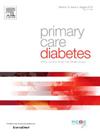丹麦北部地区疼痛性和无痛性糖尿病周围神经病变的发病率:一项基于人口的研究。
IF 2.6
4区 医学
Q3 ENDOCRINOLOGY & METABOLISM
引用次数: 0
摘要
背景:糖尿病周围神经病变(DPN)是糖尿病的一种常见并发症,但对其患病率的估计却不尽相同。本研究旨在以问卷为中心估算丹麦北部地区疼痛型和无痛型 DPN 的患病率,研究其在该地区的地理分布,并调查 DPN 与潜在风险因素之间的关联:通过电子邮件向丹麦北部地区的所有糖尿病患者发送了问卷调查。糖尿病患者的身份是通过国家医疗保险服务登记处确定的。调查内容包括人口统计学、社会经济学、城市、糖尿病类型、病程和治疗等方面的信息,以及经过验证的密歇根神经病变筛查工具问卷(MNSIq)和Douleur Neuropathique en 4 Questions(DN4)访谈问卷。MNSIq得分≥4分为可能的DPN,双脚疼痛且DN4-访谈得分≥3分为可能的疼痛性DPN:共有 23 206 名符合条件的糖尿病患者被确定为糖尿病患者,其中约 33% 回答了所有问卷。可能的 DPN 患病率为 23.3%(95% CI:22.4-24.3%),可能的 DPN 疼痛患病率为 18.0%(17.1-18.8%)。各城市之间可能发生 DPN 的比例从 22.1 % 到 35.0 % 不等,而可能发生疼痛性 DPN 的比例从 15.6 % 到 20.0 % 不等。高体重指数、糖尿病病程长、使用胰岛素、使用胰高血糖素样肽-1-类似物和低收入与 DPN 风险增加有关:结论:即使在高收入国家,无痛和有痛 DPN 的高发病率也强调了加强预防和仔细筛查的必要性。本文章由计算机程序翻译,如有差异,请以英文原文为准。
Prevalence of painful and painless diabetic peripheral neuropathy in the Northern Danish Region: A population-based study
Background
Diabetic peripheral neuropathy (DPN) is a common complication of diabetes, yet varying estimates of its prevalence exist. The present study aimed to estimate a questionnaire-centered prevalence of painful and painless DPN in the Northern Danish Region, examine its geographical distribution within the region, and investigate associations between DPN and potential risk factors.
Methods
A questionnaire-based survey was sent to all persons living with diabetes in the Northern Danish Region using electronic mail. Persons with diabetes were identified using The National Health Insurance Service Registry. The survey included information on demographics, socioeconomics, municipality, diabetes type, duration, and treatment, as well as the validated questionnaires Michigan Neuropathy Screening Instrument-questionnaire (MNSIq) and the Douleur Neuropathique en 4 Questions (DN4)-interview. Possible DPN was defined as an MNSIq-score ≥ 4, while possible painful DPN was defined as pain in both feet and a DN4-interview score ≥ 3.
Results
A total of 23,206 eligible people were identified as having diabetes and approximately 33 % answered all questionnaires. The prevalence of possible DPN was 23.3 % (95 % CI: 22.4–24.3 %), while the prevalence of possible painful DPN was 18.0 % (17.1–18.8 %). The prevalence of possible DPN ranged from 22.1 % to 35.0 % between municipalities, while the prevalence of possible painful DPN ranged from 15.6 % to 20.0 %. High body-mass index, long diabetes duration, insulin use, glucagon-like-peptide-1-analogue use, and low income were associated with increased risk of DPN.
Conclusion
The high prevalence of possible painless and painful DPN emphasizes the need for better prevention and careful screening even in high-income countries.
求助全文
通过发布文献求助,成功后即可免费获取论文全文。
去求助
来源期刊

Primary Care Diabetes
ENDOCRINOLOGY & METABOLISM-PRIMARY HEALTH CARE
CiteScore
5.00
自引率
3.40%
发文量
134
审稿时长
47 days
期刊介绍:
The journal publishes original research articles and high quality reviews in the fields of clinical care, diabetes education, nutrition, health services, psychosocial research and epidemiology and other areas as far as is relevant for diabetology in a primary-care setting. The purpose of the journal is to encourage interdisciplinary research and discussion between all those who are involved in primary diabetes care on an international level. The Journal also publishes news and articles concerning the policies and activities of Primary Care Diabetes Europe and reflects the society''s aim of improving the care for people with diabetes mellitus within the primary-care setting.
 求助内容:
求助内容: 应助结果提醒方式:
应助结果提醒方式:


